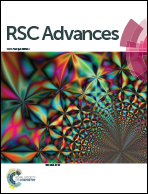Living cationic ring-opening polymerization of 2-oxazolines initiated by rare-earth metal triflates†
Abstract
The cationic ring-opening polymerization (CROP) of substituted 2-oxazolines using rare-earth metal triflates (RE(OTf)3) as initiator was investigated for the first time. In this work, we examined the polymerization characteristics of 2-ethyl-2-oxazoline (EtOx) initiated by Sc(OTf)3 under conventional thermal heating and microwave irradiation, and compared the respective outcomes with those obtained with the most frequently used initiator methyl tosylate (MeOTs). The results indicated that Sc(OTf)3 exhibits a higher catalytic efficiency to the EtOx polymerization than MeOTs under identical conditions. The controlled/living nature of the Sc(OTf)3-catalyzed CROP was confirmed by its linear first-order kinetics and the narrow molecular weight distribution of the resultant polymers as well as the block copolymerization of EtOx and 2-phenyl-2-oxazoline (PhOx). Based on in situ NMR spectroscopic studies and SEC analysis of PEtOx samples obtained from the control termination experiments, a possible initiating/propagating mechanism has been proposed for the living cationic ring-opening polymerization. Morever, this rare-earth catalytic system can also be applied to the ring-opening polymerization of some sterically hindered or aryl-substituted 2-oxazolines.


 Please wait while we load your content...
Please wait while we load your content...